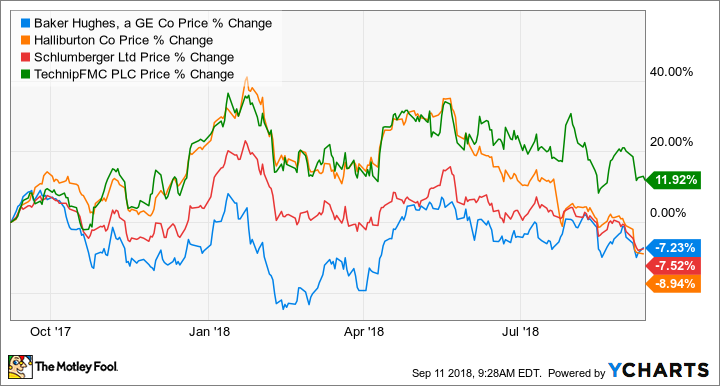When General Electric (GE 0.58%) announced it was merging its oil and gas business with Baker Hughes to form Baker Hughes, a GE Company (BKR 0.81%), it was a rather audacious bet on a new trend in the oil services industry. For investors, it has been hard to take the pulse of this company, as the combined entity came together in the midst of one of the worst oil and gas markets in decades. Also, the combination of two companies as large and as complex as Baker Hughes and GE's oil and gas operations was going to take some time to sort out.
It's been more than a year since the merger closed, and so far the company's results haven't exactly been inspiring. At the same time, though, there are some opportunities unique to BHGE because of the equipment and services it provides to the industry that could make it a compelling investment for some. So let's take a look at what makes Baker Hughes, a GE Company a potentially attractive investment and whether it is a buy right now.

Image source: Getty Images.
A unique offering in the oil services market
The merger of Baker Hughes and General Electric's oil and gas division created a new dynamic in the industry that had rarely been seen before. It was a company that provided both services such as pressure pumping and equipment sales like blowout preventers. Historically, these two businesses were separate, as oil and gas producers would bid for these things individually.
Recently, though, Baker Hughes and other large oil services providers have been acquiring equipment manufacturers in order to make all-in-one package offerings to producers. Schlumberger (SLB 0.29%) bought Cameron International, and Technip merged with FMC Corporation to form TechnipFMC (FTI 4.30%) -- both in 2016 -- to make for more competitive bids for subsea infrastructure projects. The combination of Baker Hughes and GE, though, was unprecedented, as General Electric's equipment manufacturing covered an incredibly wide swath of products for all parts of the oil drilling process as well as equipment for logistics, transportation, and refining.
The theory behind these all-in-one packages is that integrating common equipment with services improves efficiency and improves economics for its producers. In fact, BHGE has created a product known as a fullstream package through which it delivers a service that starts with the equipment and services for appraisal and goes through the entire project life. It recently won a fullstream contract for the Coral Floating LNG export facility off the coast of Mozambique.
Another aspect of BHGE that is compelling is its turbomachinery and process solutions division. This part of the business is one of the only major companies that manufactures the equipment to liquefy natural gas. The LNG market is one of the fastest-growing aspects of the fossil fuel business, and most analyst estimates say that there will be a massive supply shortage by the mid-2020s if new facilities aren't built. For its part, BHGE's management sees a 135 million-ton-per-year supply shortfall by 2030 based on current estimates of projects in operation and under construction. Supplying LNG equipment could be an incredibly lucrative market for the company over the next decade or so.
Diworsification and distractions?
So here's the catch. For BHGE to be able to capitalize on these market opportunities, a few things have to go right. One critical thing is that management is going to have to make good on its promises for operational and revenue synergies as part of the merger because, frankly, the company's margins stink compared to those of its competition.
| Company | Operating margin (trailing 12 months) |
|---|---|
| Baker Hughes, a GE Company | 3.44% |
| Halliburton | 12.1% |
| Schlumberger | 9.50% |
| TechnipFMC | 8.93% |
Data source: Y-charts.
CEO Lorenzo Simonelli says that the company will be able to realize $1.6 billion in annual operational synergies by 2020 as the company puts the finishing touches on its integration plan. The concern that many investors should have is that the diverse offerings BHGE has in its portfolio make the company less focused.
To be fair to the company, its margins have been improving -- operating margin was 6.6% for the second quarter. However, margins have been improving at its peers as well, so this is just as likely a product of an improving market as of BHGE's efforts to improve margins. Over the next few quarters, it will be worth watching the company's results to see whether it can get its margins back in line with those of its peers. If not, then it's entirely possible that BHGE will suffer from the same malaise as General Electric did with too many divisions and not enough concentration on generating high returns from a smaller portfolio.
Potential that might not be fulfilled
Baker Hughes, a GE Company is very much one of those companies in which you can see the potential of its business on the horizon, but the path to get there is uncertain. It's unparalleled offerings in both services and equipment for the oil and gas industry mean it can do some things that no other company can, and offerings like its fullstream services and its turbomachinery business could fill a major need over the next few years.
Whether the company can turn that market opportunity into bottom-line results is yet to be seen, though, and it's just as likely that the company suffers from trying to do too many things at once instead of doing a few things exceptionally well.
Baker Hughes, a GE Company could be a good addition to a portfolio if the company can realize the cost synergies and close the operating margin gap as management has promised it would. It has made some baby steps in that direction, but until we see the company show significant progress, I think it is best to wait this one out for a bit.






